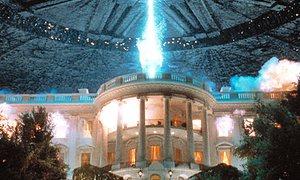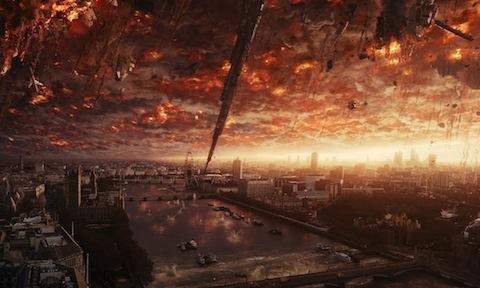“They like to get the landmarks,” Jeff Goldblum in the trailer for Independence Day: Resurgence. Not the most tactful comment, given that London is buried by an avalanche of alien debris two seconds later, but maybe Goldblum has seen the city demolished too often for it to bother him any more. Just this year Michael Fassbender levitated Tower Bridge into oblivion in X-Men: Apocalypse; in London Has Fallen, the rest of the capital took a battering; in GI Joe: Retaliation, Jonathan Pryce dropped a metal rod from an orbiting satellite right on to Westminster. Not that London is the only city to suffer such insensitive remodelling. The razing of national landmarks – to the accompaniment of a blase one-liner – is such a regular cinematic occurrence that it’s hard to remember when audiences were shocked and awed by it. How did we get to this point? When did mass destruction become a blockbuster norm? To see where this regrettable trend got started, look no further than the first Independence Day, which was released 20 years ago.
Co-written in just three weeks by its German director, Roland Emmerich, and its American producer, Dean Devlin, Independence Day has rapacious extra-terrestrials flying to Earth, undetected, in a mothership that is one-quarter the size of the moon. The ship then spits out several flying saucers, each of them 15 miles wide, which hover above our major population centres like Old Testament storm clouds, before disintegrating them with laser beams (or something). That was the instant when the summer blockbuster became something far more apocalyptic and far less fun. Independence Day went on to be the biggest box-office hit of 1996, and it’s tempting to say that its influence, like those humongous spaceships, has overshadowed Hollywood ever since.

The money shot … the famous exploding White House scene from Independence Day, 1996 – created using a 5ft-high plaster model. Photograph: Everett/REX/Shutterstock
The film’s key moment, its money shot, is the obliteration of the White House. It has subsequently been imitated and parodied to the point where it now seems innocuous but, at the time, Emmerich and Devlin struggled to get the sequence past executives at Fox. Timothy McVeigh had bombed the Federal Building in Oklahoma a few months earlier, and the executives were afraid that the White House scene would be too close for comfort. Emmerich and Devlin, on the other hand, knew how great the sequence would look in the trailer, so they scheduled it for the start of production, before the executives could get cold feet. Making use of techniques that now seem quaintly traditional, they built a detailed plaster model of the White House, 15ft wide and 5ft high, then blew it up with six cameras rolling. The spectacular footage was rushed round to Fox, and the executives’ objections were forgotten.
And there was plenty more property damage where that came from. In the same minute that the White House goes up in flames, the Empire State Building is turned into a Roman candle, and cities all over the planet are evaporated. Twenty years on, these setpieces are still horrifying. Independence Day combines CGI with practical effects, so it’s quite shocking to see real cars and lorries being flipped over, and real torrents of burning gas consuming everything in their path. But if these sequences are upsetting to the viewer, the characters are more relaxed. “At one point,” wrote Roger Ebert in his review for the Chicago Sun-Times, “the news comes that New York, Washington and Los Angeles have been destroyed, and is there grief? Despair? Anguish? Speculation about what that will mean for professional sports? Not a bit – the characters nod and hurry on to the next scene.”
In fact, Ebert was being kind. The characters don’t just nod, they wisecrack. And they don’t even wait until the destruction is over before they wisecrack; they fit in a punchline or two during the carnage. When a firestorm roars towards Harvey Fierstein, he mutters, “Oh crap,” thus inviting us to chuckle at his imminent immolation. You can hear that flippancy being echoed in X-Men: Apocalypse. Never mind the thousands of innocents who are slaughtered by Fassbender (all right – by Magneto) when he reduces our landmarks to scrap metal, the supposed good guys forgive and forget his butchery immediately afterwards. The legacy of Independence Day is a glut of films that aren’t just about global devastation, but about selective amnesia.
To those of us who saw it in 1996, it was apparent that its holocaust-comedy tone wasn’t quite right – that Independence Day lacked the innocent fun of the blockbusters that preceded it. Buildings had tumbled in films before, of course: Emmerich and Devlin were paying homage to Irwin Allen’s The Towering Inferno, among other disaster movies. But since Allen’s early-70s heyday, our big-budget summer entertainment had become lighter and quirkier. It was populated by grubby academics busting ghosts, a hapless archaeologist failing to get hold of mystic idols, and a skateboarding kid who just wanted to get back to the future. Even James Bond managed to save the world without cities being wiped off the map, and the genocide in Star Wars happened in outer space and at a distance: we weren’t asked to watch Alderaan’s civilians being vaporised by the Death Star.
Emmerich had been a devotee of these 1970s and 1980s classics. Born in Stuttgart in 1955, and raised in nearby Sindelfingen, he went to Munich’s University of Television and Film in 1977, but it wasn’t until he saw Star Wars that he decided to enrol in its directing course. “For me,” he is quoted as saying in Tom Shone’s book Blockbuster, “German movies were boring and dull, and everything that came from the new Hollywood was cool.” Later, he was nicknamed “Das Spielbergle aus Sindelfingen” (“Little Spielberg from Sindelfingen”), and when he made Independence Day, he aimed it at “people who loved Star Wars and loved Spielberg movies and wanted these movies back”.
As sincere as his admiration for Steven Spielberg and George Lucas may have been, their magic eluded him. Spielberg rooted ET: The Extra-Terrestrial and Close Encounters of the Third Kind in the bike-riding, T-shirt-wearing suburban America of his childhood, whereas Emmerich set Independence Day in the America he had seen in the movies. Spielberg saw aliens through the eyes of ordinary, flawed people, whereas Emmerich gave us a US president (Bill Pullman) who was a Gulf war veteran, plus a cigar-chomping fighter pilot (Will Smith) with a stripper girlfriend (Vivica Fox) and a macho eagerness to “whup ET’s ass”. People who loved Star Wars and Spielberg movies weren’t impressed.
There was also the weirdness of the film’s immense scale, an Emmerich-Devlin obsession that was summed up by the slogans advertising their next collaboration, 1998’s Godzilla: Size Does Matter. That film’s trailer, which was wittier than the product it was promoting, even had Godzilla’s massive foot crushing a Tyrannosaurus rex skeleton in the New York’s American Museum of Natural History. The cheeky message: so much for Jurassic Park. Anything Spielberg can do, we can do ... well, not better, but certainly bigger.
By the time Godzilla came out, the reverberations made by Independence Day were already being felt. Wikipedia credits James Cameron’s Titanic with having revived the disaster movie genre, but Independence Day was released a year earlier. And there is no doubt which film was being copied by Armageddon and Deep Impact, the first and sixth biggest hits of 1998. Suddenly, blockbusters were joyless, bloated and militaristic. They featured extinction-level events, martial snare drums on the soundtrack, and grave presidents played by Morgan Freeman, saying, “May God have mercy on us all.” The Chrysler Building, the Eiffel Tower and Big Ben took it in turns to topple, as cities were flattened by atom bombs (The Sum of All Fears), superheroes (Man of Steel, The Avengers), giant robots (Transformers) and lizards from another dimension (Cloverfield, Pacific Rim). Either because of Hollywood’s lack of imagination, or our anxieties about climate change and terrorism, or the simple matter of CGI making it easier than ever to put doomsday scenarios on screen, the influence of Independence Day spread so far that it reached even Spielberg. In his third close encounter with aliens, 2005’s War of the Worlds, his usual optimism had been replaced by a nightmarish vision of the end of days. ET had had his ass whupped, indeed.
Whether the film’s influence extended beyond the movies and into reality is another question, but when the World Trade Center was attacked in 2001, it was often said that footage of the crumpling Twin Towers could have come from a Hollywood movie – and one Hollywood movie in particular. Joe Viskocil, the pyrotechnics expert who designed The White House explosion in Independence Day, went so far as to say that he felt partially responsible. “I felt guilty about making my work look so good,” he says. “I started thinking maybe I did my job too well, and it might have been the nucleus of an idea for someone to say: ‘Hey, let’s crash a plane into the White House.’” But no one else in Hollywood showed much remorse. Directors, Emmerich included, kept on knocking down New York landmarks as if nothing had happened.
But here’s the most depressing part: if you rewatch Independence Day now, it holds up better than most of the films it inspired. It has a just-about coherent plot, a couple of clever twists, and a victory that depends on planning, co-operation and self-sacrifice. It isn’t adapted from a series of comics or YA novels, and it isn’t a set-up for a sequel. It has black and Jewish heroes, a gay character, and enough women to pass the Bechdel test. By today’s standards, it’s an amazingly inclusive and progressive blockbuster – and that’s a blood-curdling thought. In 1996, Independence Day felt like the end of the world as we knew it. What does it say about current cinema that it now doesn’t seem so bad, after all? May God have mercy on us all.


Spread the word